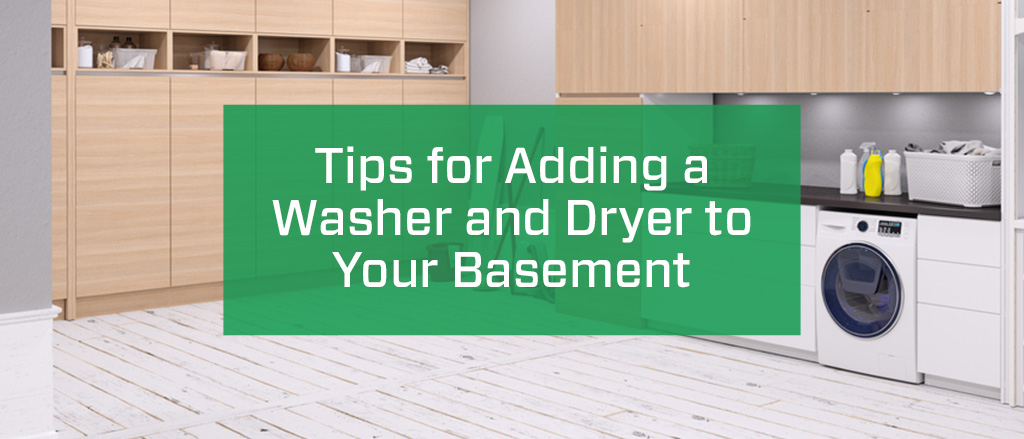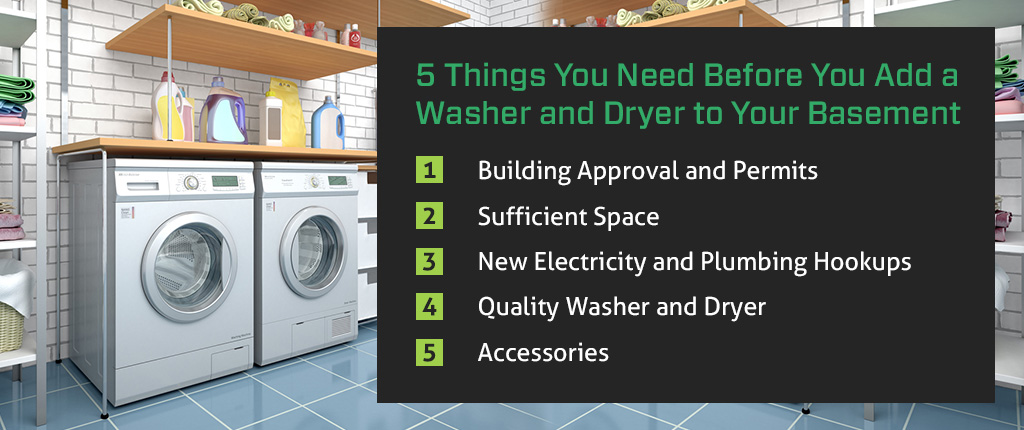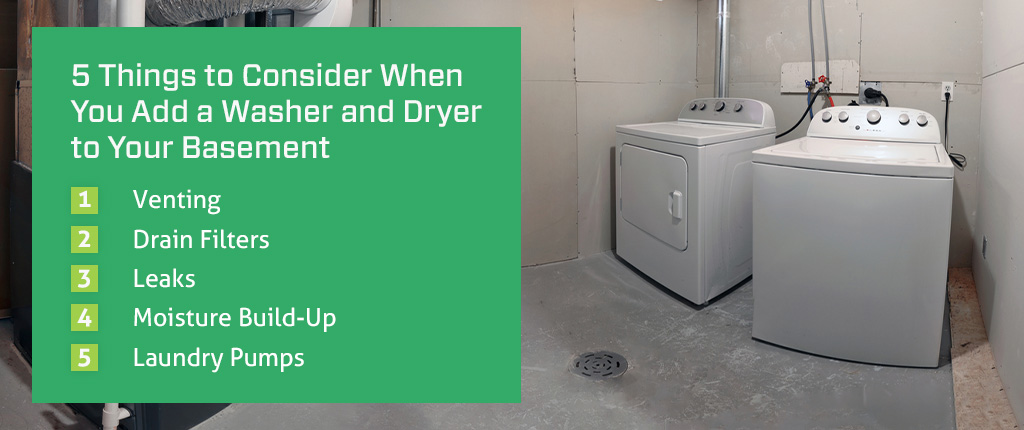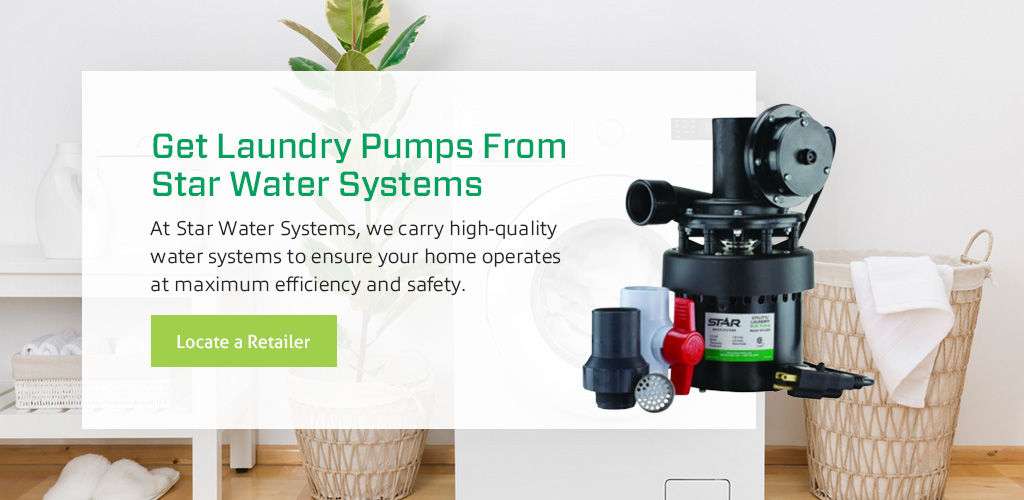Tips for Adding a Washer and Dryer to Your Basement

Putting a laundry room in your basement can be a great way to improve your home layout without sacrificing design. Using your basement can help reduce intrusive noises, minimize potential water damage and allow you to build out your dream laundry space.
Adding a washer and dryer to the basement will take a bit of planning, and you may need to be prepared to rework your plumbing and electricity. To help you get started, here are some tips for adding laundry appliances to your basement.
5 Things You Need Before You Add a Washer and Dryer to Your Basement
Before you can start your laundry set up, you’ll need to get all your ducks in a row. The last thing you want is to discover utility or permit issues after investing in your new laundry setup. Here are some of the things you’ll need before starting your basement laundry:
1. Building Approval and Permits
Installing laundry means clearing any approvals and permits beforehand. Since laundry involves plumbing and electrical work, you’ll need to navigate some regulations around its installation. If you’re in a condo, you’ll need to check with your building’s board to ensure you can make the necessary changes. You may only be able to install your laundry units in pre-approved areas, regardless of the space you might have.
If you’re a homeowner with your own house, you’re your own approval board! However, you’ll still have to get the correct permits if you need new plumbing or electrical work.
2. Sufficient Space
You can only install laundry machines in the basement if you have the space for them. Make sure your basement has enough room to comfortably fit your washer and dryer, along with any storage and gadgets you might need. Remember, you’ll also want room for shelving and storage. Laundry involves detergents, dryer sheets and hanging clothes — all things that need space.

3. New Electricity and Plumbing Hookups
If your basement lacks the proper hookups, you’ll need to add those in. Have an electrician confirm that your home can handle the added electrical load before you add a dryer to your basement. They may need to install a circuit breaker to help prevent fires.
If your basement lacks the plumbing to meet your laundry needs, you’ll also need to hire a plumber. While you may feel like your wallet’s sprung a leak now, it’s essential to have utilities that can meet your needs.
4. Quality Washer and Dryer
If you want to do laundry, you’ll need a washer and dryer — unless you want to go old-school with a washboard, tub and clothesline.
As exciting as new appliances can be, avoid buying the first units you see. Take your time and do your research to find the best machines for your needs. Technological advances have led to hyper-efficient, convenient machines, but you’ll still need to shop around to find a setup that meets your laundry requirements.
5. Accessories
Okay, accessories aren’t quite as “essential” as permits or a washer and dryer. However, laundry accessories can bring a space to life! With the right accessories, you’ll make your basement laundry feel like your own space.
Use baskets, glass containers and wall décor to give the space personality and make it feel like part of your home. Use curtains or doors to separate the space and try to include as much storage as possible.
While you don’t need to have all your accessories beforehand, planning them out ahead of time will help you envision your space as you want it. If you have a finished basement, ensure the accessories complement the existing design.
Benefits of Adding Laundry to Your Basement
There’s nothing more convenient than having your own fresh, updated laundry room. Adding a washer and dryer to your basement can help boost the value of your home and make your life easier. Here are some of the benefits you can expect to enjoy with your basement laundry:
1. Less Intrusive
With laundry near living areas or in a kitchen or mudroom, you won’t be able to escape the sound of your washer and dryer when you want to wash some clothes. Putting your washer and dryer in the basement puts them at a distance from the rest of the house, minimizing laundry noise.
As a bonus, you won’t have to deal with your washer and dryer ruining the aesthetics of your other spaces. By moving your laundry to the basement, you’ll enjoy peace and quiet whenever you start a load and you can experience your home without cluttered appliances.
2. Easier Installation
Many homes already have plumbing and electrical hookups in their basements, making installing a washer and dryer there much easier. If you don’t have the correct electrical and plumbing for a laundry hookup, the basement is likely the best place to add one. Basements are also often easier for electricians and plumbers to work with since there are usually fewer walls to maneuver around.
3. Less Chance of Flooding Damage
No matter how good your plumbing is, there’s always a risk of flooding when you’re dealing with appliances and water. Adding a washing machine to your basement reduces the risk of damage to your home from a leak or other plumbing issues. If only the basement floods or takes on water damage, you won’t have to worry about water ruining the upper floors.
4. Convenient Layout
You won’t have to work around your living room, bathrooms and other living spaces, so you’ll have more freedom with your laundry build. Since basements often have a more open-concept space, you can custom-design your basement laundry to fit your needs. You can build a laundry room with all the shelving, storage and walls you need.

Cons of Adding Laundry to Your Basement
While a basement laundry room comes with many benefits, there are also some downsides. You’ll want to weigh all your options before deciding on your installation spot. Here are some cons that could affect your decision to locate your laundry in the basement:
1. Easy to Forget
When it’s harder to hear the washer and dryer, it’s easier to forget to switch your laundry out when it’s done. Most laundry appliances have alerts that go off when your laundry is complete, so you don’t leave it sitting in the washer or dryer for hours. With your machines in the basement, you may not hear those alerts when they go off. If you frequently forget about your laundry, you may want to keep your appliances closer to your living spaces to help you remember to switch them out.
2. Harder Access
Having your washer and dryer in the basement means you’ll have to go up and down the stairs whenever you need to access your laundry. Stairs can make laundry inconvenient for homeowners, especially those with limited mobility or chronic pain. When installing a basement laundry, keep in mind all the legwork you’ll have to do whenever you want to start, switch over and finish a load. Some homeowners prefer having their laundry upstairs to avoid all that stair climbing.
3. Heavy Machinery
Washers and dryers are extremely heavy. If your basement doesn’t have outside access, moving them down the stairs and installing them in the basement can be challenging. Lack of outdoor access might not be a significant inconvenience if you hire someone to install your units downstairs. However, you’ll need to budget another $50-175 if you opt for professional installation.
5 Things to Consider When You Add a Washer and Dryer to Your Basement
You’ll have to consider several issues and necessary features when you add a washer and dryer to your basement. You need to make certain preparations to minimize leaks, blocks or fire hazards — building these preparations into your laundry room ahead of time will save you some severe headaches down the road.
Here are installation considerations you’ll need to plan for when designing your basement laundry room:
1. Venting
Every washer and dryer needs ventilation. Vents send out excess heat and gases that could become fire and safety hazards if allowed to build up inside. Installing a P-trap in the drain pipe will take care of venting for your washing machine.
Venting your dryer is fairly simple if your basement has outdoor access. Consult a technician to determine if it will be easier to vent through a window or the wall. If your basement is underground, you’ll need to run the vents up and out to ensure your laundry meets safety standards.

2. Drain Filters
With washers that drain into a sink, a drain filter catches debris and stops it from flowing out with the used water. You’ll need to clean the drain filter regularly to prevent a build-up of particles, debris and grime. The drain filter will clog if it collects too much debris, preventing water from flowing out and causing it to flood your laundry area instead.
3. Leaks
Washers will inevitably have some leaks over time. You should check your machine regularly for small drips and leaks. While they might not seem like a significant issue at first, they’ll quickly become severe water issues if you leave them unchecked.
Ensure the device isn’t flush with the wall to avoid kinks that can lead to premature leaks. If you notice leaking, contact a professional to help you fix your laundry machines before the problem worsens. If your appliances are worn out and leaking often, you’ll want to replace their lines and metal washers.
4. Moisture Build-Up
Venting and regular checks alone won’t remove the excess moisture your laundry generates. Moisture build-up can lead to mold and mildew, cause paint to peel and even lead to wood rot in extreme cases.
Consider getting a dehumidifier to remove excess moisture from your basement. You’ll also want to ensure your water supply lines and ducts are well-insulated. Condensation can form around these components during cold weather, causing moisture build-up that might lead to water damage.
5. Laundry Pumps
Many basements are below the sewer elevation, which means appliances can’t drain using gravity and need a washing machine pump to drain away the water. If your basement is lower than the sewer lines, you’ll need a laundry pump to ensure your appliances work properly. Get a high-quality laundry pump for your system to get the best use and drainage out of your appliances.
Basement Laundry Maintenance
Once your basement laundry is set up and ready to go, it will need regular cleaning and maintenance to ensure your appliances have a long life. Here is a short maintenance checklist to help prevent laundry issues:
- Clean drain filters: Regularly clean your drain filters to clear any debris. Preventing this build-up keeps your filter from blocking the water flow and helps prevent flooding.
- Remove lint: Always clear lint from the lint trap with every dryer use. If too much lint accumulates in your lint trap, it will eventually clog up the dryer vent and cause excess humidity, blockages or even fires.
- Check for leaks: Leaks signal an issue that needs addressing, so inspect for leaks regularly. Contact a professional if you see leaks spring up around your washer and dryer. You might need to replace the hoses, or there could be a larger issue.
- Leave room: Leave space between the wall and your washer and dryer. Having space avoids kinks in the hoses and makes it easier for you to clean behind the machines and check for leaks.
- Clean washer: Buy washing machine cleaning tablets and use them to give your device a deep clean. Grime and scum will build up in the washer over time. Washing machine cleaning tablets will remove this build-up and help your clothes come out cleaner.
- Avoid fabric softener: Fabric softener coats your laundry with a soft film that leads to cakey build-up in your machines and pipes. This build-up can lead to excess moisture and even mold growth. Opt for dryer balls to save your appliances, laundry and pipes.
 Buy Now at Lowes
Buy Now at Lowes